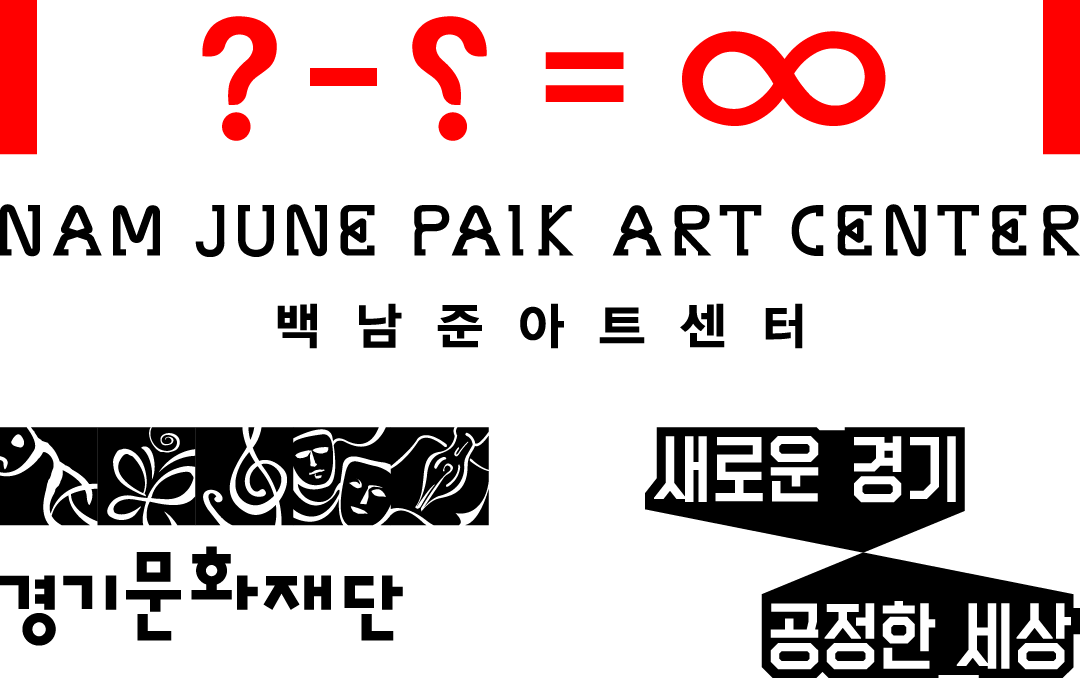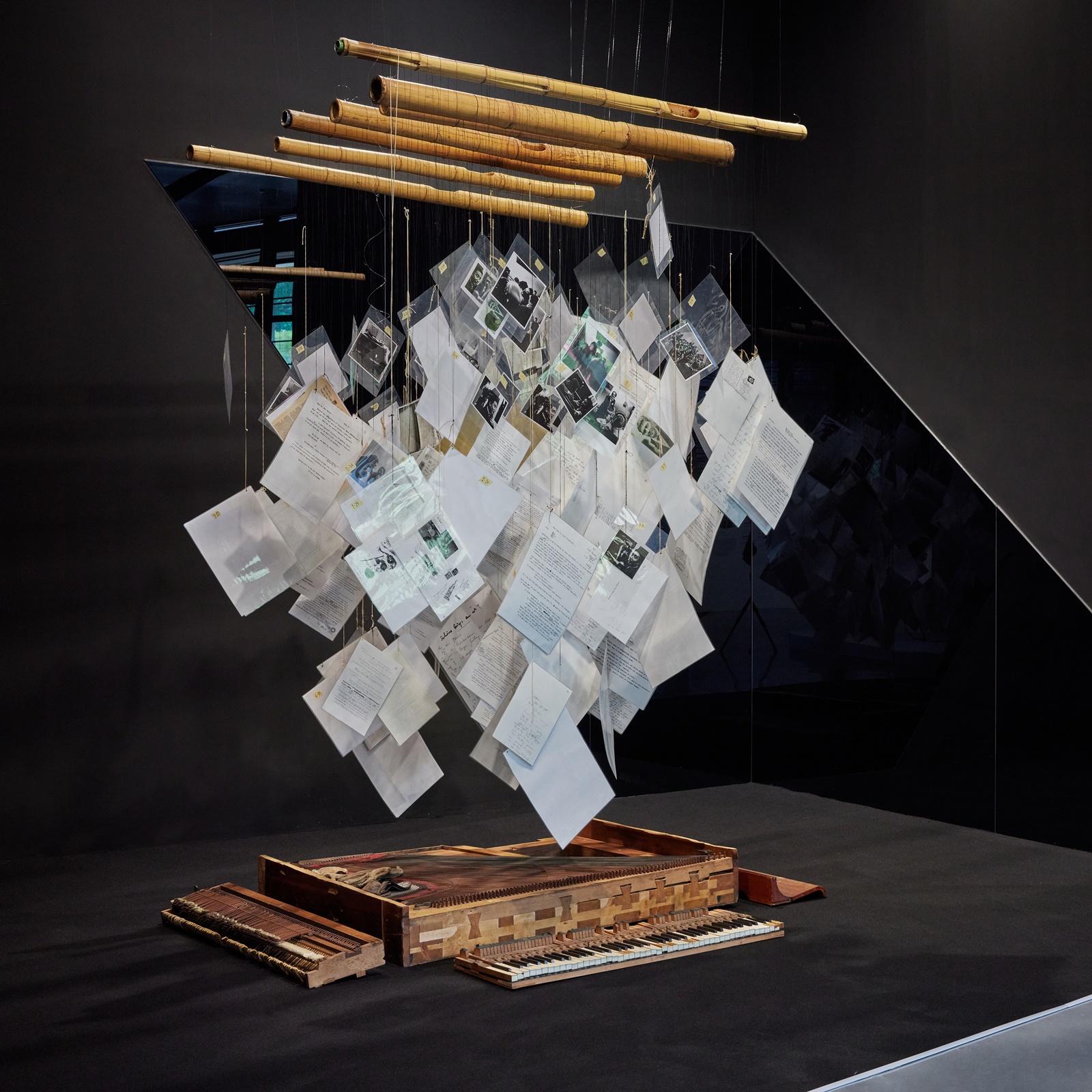
Nam June Paik, Mary Bauermeister, Piano & Letters, 1960(Piano)/1962-1980(Letters), variable, dismantled piano, copies of documents, images, letters from Nam June Paik
Exhibition
Something like an Appleseed
Apr 27, 2023 – Feb 12, 2024
Venue
Gallery 1, Nam June Paik Art Center
Artists
Nam June Paik, Aldo Tambellini, Allan Kaprow, James Seawright, Jud Yalkut, Mary Bauermeister, Manfred Leve, Manfred Montwé, Otto Piene, Thomas Tadlock
Curator
Cho Kwonjin
Graphic & Space Design
Jang Hyojin
We have a thing called art and we have a thing called communication, and sometimes their curves overlap. (A lot of art does not have much to do with communication and a lot of communication has no artistic content.) In the middle there is something like an appleseed, and that is our theme―maybe our dream, too. (Nam June Paik, Random Access Information, 1980)
In March 1980, Nam June Paik gave a talk titled “Random Access Information” as part of the series Video Viewpoints, which was organized by curator Barbara London of the Museum of Modern Art in New York. Contrasting with the magnetic tape playback approach of reading information sequentially, “random access” refers to the spontaneous reading of information in any desired location, as in computing. During his talk, Paik drew two overlapping circles, writing “art” in one and “communication” in the other. Where the two circles overlap, he said, was “something like an appleseed.” What sort of “seed” was it that provided this lecture with its theme, and that Paik himself described as a dream? The artist saw this seed as the potential harbored within video art. He believed that random access to video―as a means of recording and storing information from every moment in human history―was an important step toward overcoming problems of communication. To help this seed to sprout, he created video art by cutting and splicing information from the endless records of time. He also enabled more people to see his video work by broadcasting it not simply to museum visitors but to viewers of television, a medium that allowed for dissemination at an unlimited scale.
The biggest problem of communication is disconnection. When people are unable to meet and know one another, misunderstandings and prejudices build up, closing off the path forward. But as art and communication meet, they can become each other’s media. The methods of execution diversify as each becomes a powerful tool for the other, leading them to unpredictable places. Paik had already predicted that with its reorganization and editing of time, video artwork offered a way of transcending the bounds of time and space to connect people who had been unable to meet before and to create new relationships. He presented the work Random Access at his first solo exhibition in 1963, Exposition of Music – Electronic Television. It was designed so that viewers could scrape the desired portion of a magnetic tape to hear the musical information recorded on it―enabling the creation of sound through audience participation. The works of avant-garde art that Paik produced from the beginning of his artistic career exist as nutrients within that seed, which harbors all the unlimited potential for what may arise when video art―and art in general―intersects with communication. Today, we live in an era when we are no longer constrained by space or time: we can connect at any time, meet anyone, and form or discover any kind of relationship we want. It’s time for us to nurture Nam June Paik’s appleseed to sprout in a certain new way.
Organized and Hosted by
Nam June Paik Art Center, Gyeonggi Cultural Foundation
Contact
kwonjin@njpartcenter.kr / 031-201-8546
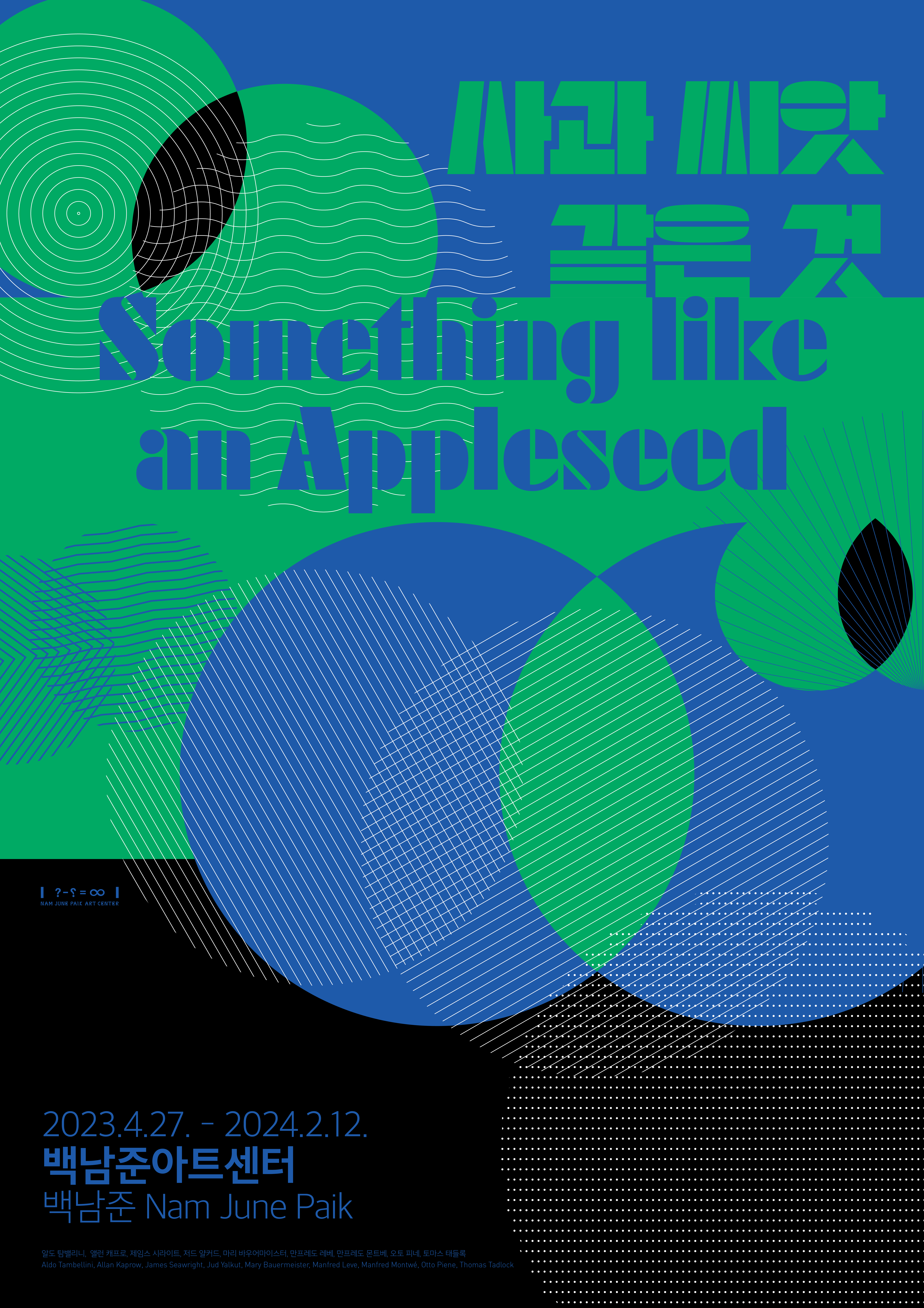
Something like an Appleseed

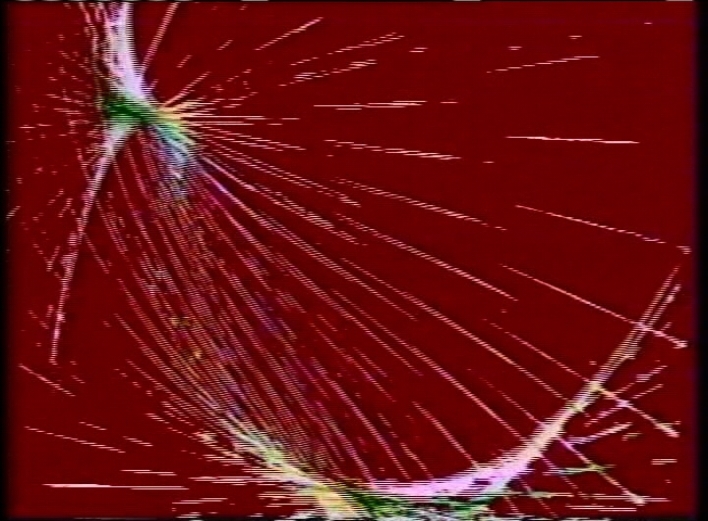
Nam June Paik, Allan Kaprow, Otto Piene, James Seawright, Thomas Tadlock, Aldo Tambellini,The Medium is the Medium

The Medium is the Medium broadcast on WGBH Boston on March 23, 1969 was the U.S.’s first television program about video art, featuring the works of six artists. “What happens when artists take control of television? […] They all see in television an immediate way of reaching a vast audience and creating a museum for millions.” Beginning with this narration, this program consisted of Aldo Tambellini’s Black, Thomas Tadlock’s Architron, Allan Kaprow’s Hello, James Seawright’s Capriccio, Otto Piene’s Electronic Light Ballet, and Paik’s Electronic Opera No.1. About five–minute long, Paik’s work televised an accidental composition of images out of a dancer’s movements with three hippie men’s faces produced in real time, found footage of President Nixon and his attorney John Mitchell, and various dancing patterns recorded from his experimental televisions. Electronic Opera No.1. can be characterized by the processing techniques to create eerie and overlapped images, and the narrations to engage viewers, such as “This is participation TV,” “Close your eyes” and Two–third open your eyes.”
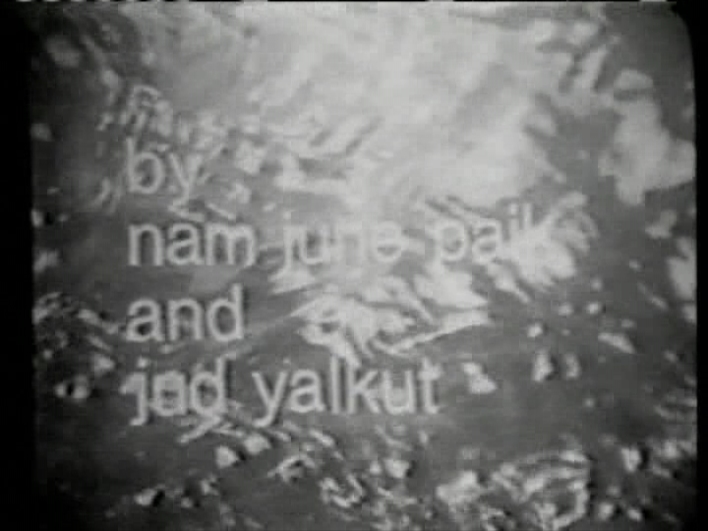
Nam June Paik, Jud Yalkut,Electronic Moon No.2

Nam June Paik and Jud Yalkut co-produced Electronic Moon from 1966. After they made the moon images with the red, green, blue phosphorus, Yalkut filmed it. The first moon, produced as a black and white video, appeared and disappeared by itself, and the electronic interference being shot into there could make it shimmer. Later, in 1967 they used a filter to color the moon and put Glenn Miller’s Moonlight Serenade as music in the video. In Electronic Moon No. 2 produced in 1969, black and white images of the moonlight shining into waves emerge are accompanied by Claude Debussy’s Claire de Lune in the background. The moon image varies in color and shape, sometimes reflecting Paik’s silhouette on it, or becoming a dish with a fork and knife placed together.
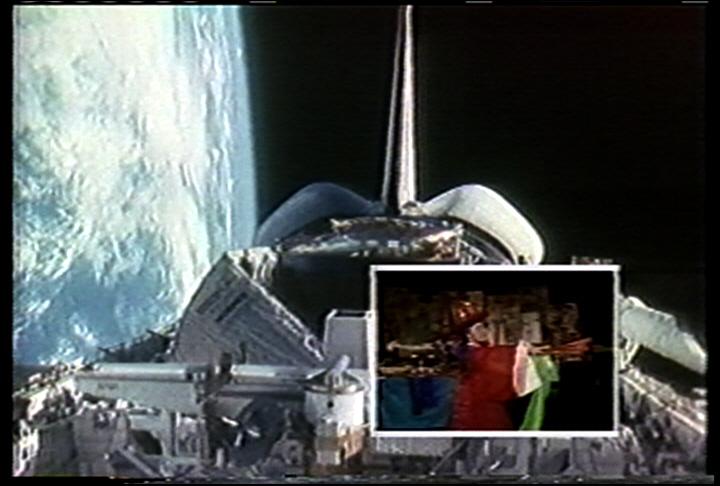
Nam June Paik, Bye Bye Kipling

Nam June Paik`s second satellite project, Bye Bye Kipling refuted British novelist Rudyard Kipling who said, “East is East and West is West, and never the twain shall meet.” It shows that the East and the West can meet each other through music, art, and sports. From 10am on October 5, 1986, a live broadcast from New York, Tokyo, and Seoul was aired on WNET in the U.S., followed by recorded broadcasts in Japan and Korea. The piece begins with an introduction composed of the Beatles` Come Together, a Korean Janggu performance, Keith Haring`s sketch performance, and computer graphics connecting the East and the West. New York and Tokyo were set up as studios for the two way live broadcast, and performances by Lou Reed and the Philip Glass Ensemble were held at each venue, and also there were the parts featuring Ryuichi Sakamoto, Isozaki Arata, and Issey Miyake with their works of music, architecture and fashion. Overall, the entire video showes traditional and modern culture of the East, such as Nongak, Chajeonnori, Sumo, and Namdaemun market merchants, intersected with performances in New York and Tokyo studios, and accompanied by the marathon race of the Seoul Asian Games. As the marathon`s finish line draws nearer, the tension of the race reaches its peak with the performance of the Philip Glass Ensemble, and the video ends with the Video Ball performance by Sakamoto and Paik in Tokyo.
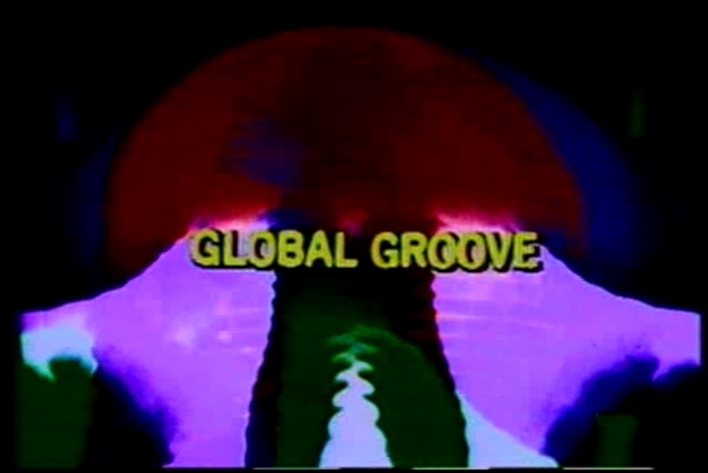
Nam June Paik,Global Groove

Paik’s seminal video, this work as implied in the word “groove,” to cheerfully dance or listen to music with an insistent rhythm, proposes music and dance, which are nonverbal expressions, as a method of global communication. It embodies a lively “global village” by means of the collage of diverse artistic and cultural forms together. Produced in 1973 and aired on January 30, 1974, WNET, the video starts with the introduction, “This is a glimpse of a video landscape of tomorrow when you will be able to switch on any TV station on the earth and TV guides will be as fat as Manhattan telephone book.” This video presents rock ‘n’ roll and a Navajo woman’s drumming, a Korean fan dance and a tap dance, Charlotte Moorman’s performance and John Cage’s interview, and so on. The dazzling 22 sequences of music and dance from different parts of the world are unfolded as if by zapping. Born out of Paik’s typical style of video synthesis, the images look like the digital ones though it was made with an analogue video synthesizer.
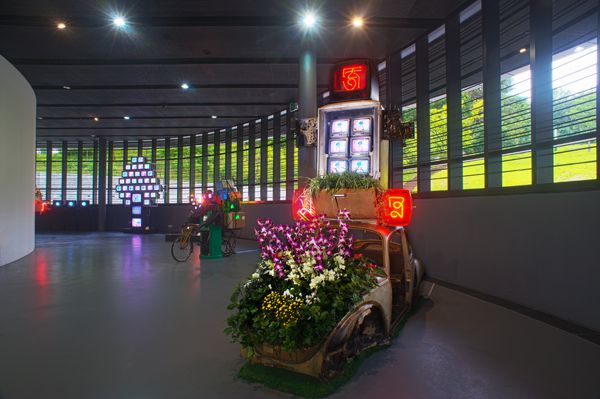
Nam June Paik,Marco Polo

Marco Polo, produced for the Venice Biennale in 1993, takes the form of a robot representing a historical figure who moved across the East and the West. Paik titled his exhibition, Electronic Superhighway: From Venice to Ulan Bator, and layered the historical highway used in the exchange of the East and the West, with the electronic highway. Marco Polo of the 20th century rides a Volkswagen Beetle that has its engine room filled with flowers. The face and feet of Marco Polo are made up of hieroglyphic characters made of red neon. His body, constructed with six televisions, displays quickly changing images of Eastern and Western architecture and abstract electronic images that resemble the atomic fission. Marco Polo runs on the ‘electronic highway’ that connects the world through broadband communication, allowing you to experience not only the various past time periods but also the future.
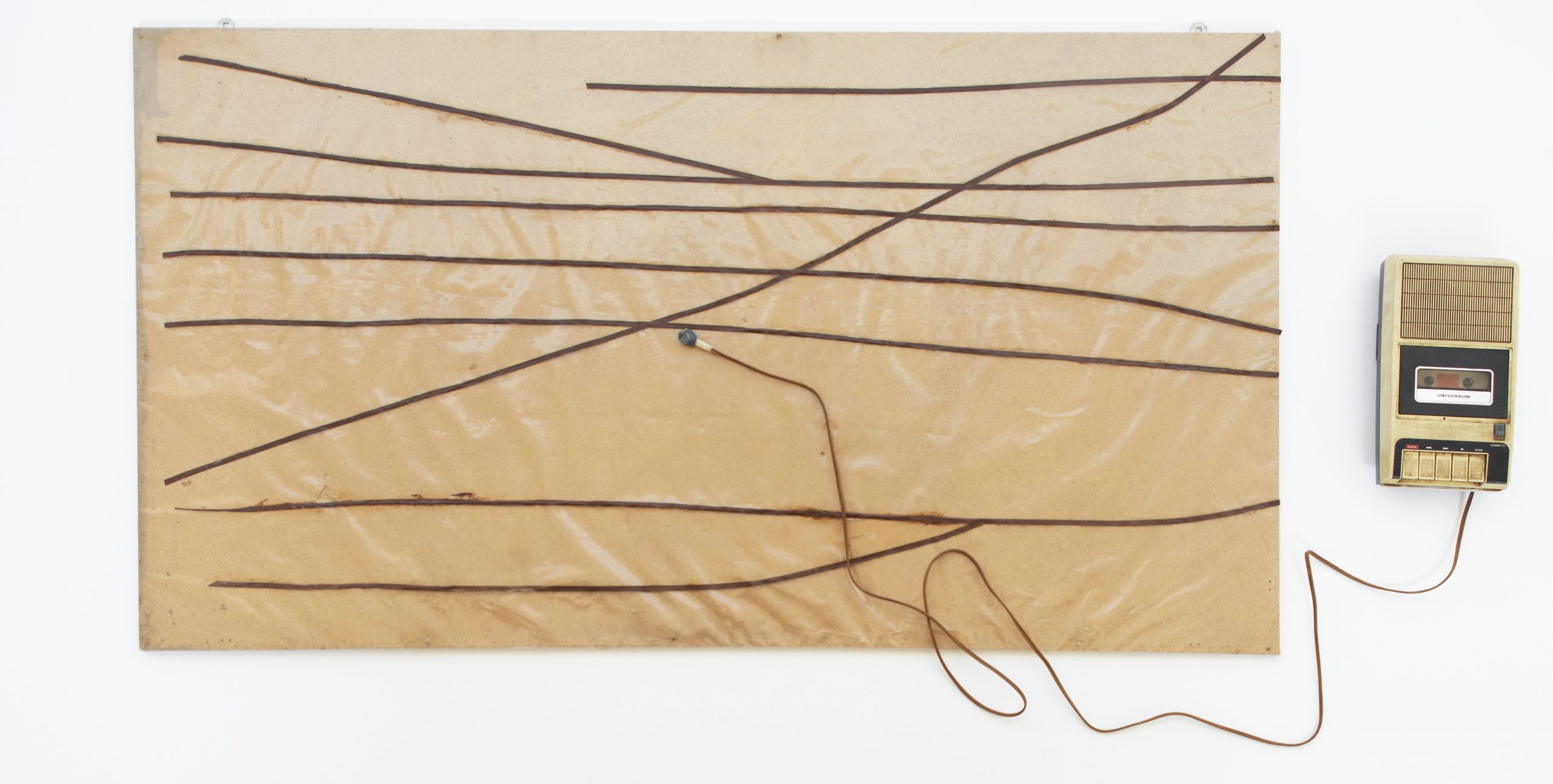
Nam June Paik, Random Access Audio Tape
chipboard, plastic foil, audio tape strips, portable cassette player, magnetic tape head

Nam June Paik presented Random Access in his solo exhibition at Galerie Parnass, Wuppertal in 1963. Fragments of magnetic tapes unwound from a spool were attached to the wall, and visitors with a metal tape-head separated from playback equipment could scrape the point they wanted to listen to. Later, for the exhibition, Sehen um zu hören, at the Städtische Kunsthalle, Dusseldorf in 1975, Paik reconstructed this work and called it Random Access Audio Tape. This work consists of a chipboard to which magnetic tapes were attached, instead of a wall, and a playback head connected to a portable cassette player. Like the first work, viewers could directly scratch the tape and play the sound.
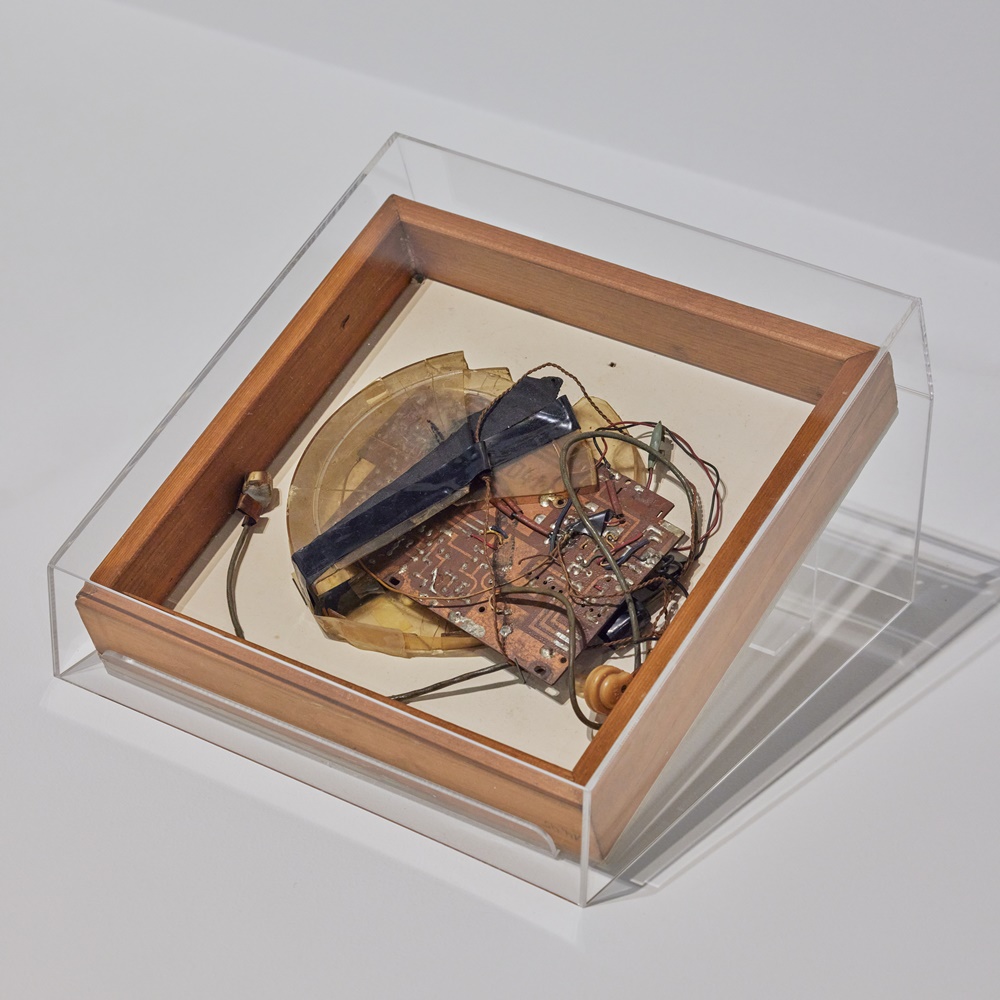
Nam June Paik, Audio Tape Head with Extension
magnetic audio tape head with extension, circuit board, head phone, battery cable, plastic cover for audio or video tape, wooden box

Nam June Paik presented Random Access in his solo exhibition at Galerie Parnass, Wuppertal in 1963. Fragments of magnetic tapes unwound from a spool were attached to the wall, and visitors with a metal tape-head separated from playback equipment could scrape the point they wanted to listen to. After this exhibition, the playback head was lost and Paik reproduced it in 1964. The reproduced playback head, battery cable, and headphone connected to circuit board are assembled in a wooden box.
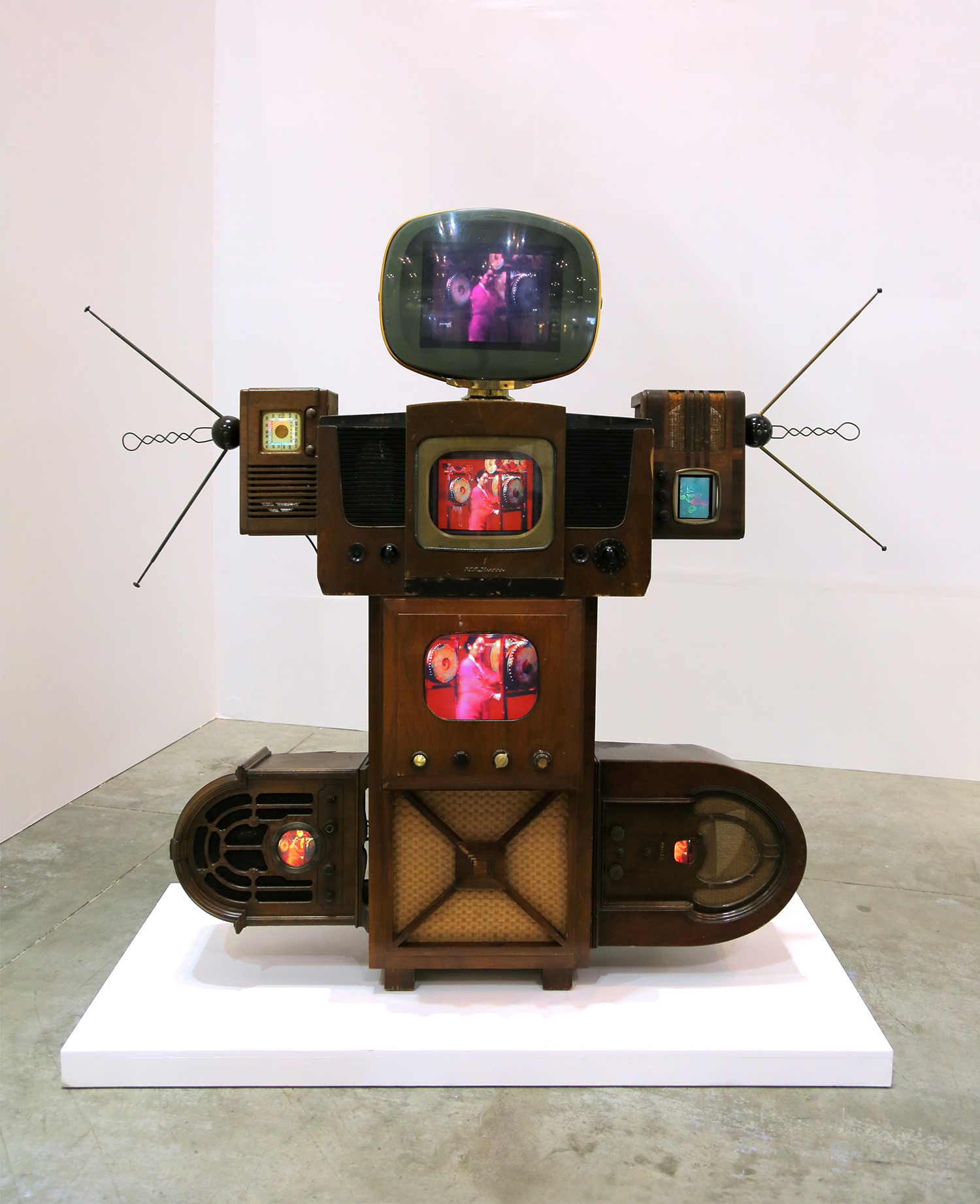
Nam June Paik,Yulgok

Yulgok is one of Nam June Paik’s robot series that are based on Korean figures. The robot represents the 16th-century Confucian scholar and politician Yi I whose pen name is Yulgok. The head is made with a monitor of an old vacuum tube television; the chest and belly contain monitors; two ball-shaped antennae hang from its two arms. Rounded-edge radios are placed on both sides as two legs so that the robot looks like sitting with its legs crossed. The robot overall takes on a stable and well-balanced shape. Paik’s sense of sculpting is demonstrated in his use of the visual forms of components in the way suggestive of the robot’s bodily gesture and posture. On the seven monitors, such videos as Korean fan dance are played back in a speedy and flashy way adding vitality to the whole work. The contents of the past like the figures in Korean history are rendered in the form of a robot employing television and video. It may be said that, in representing historical figures through media technologies, Paik drew the past, present, and future together.
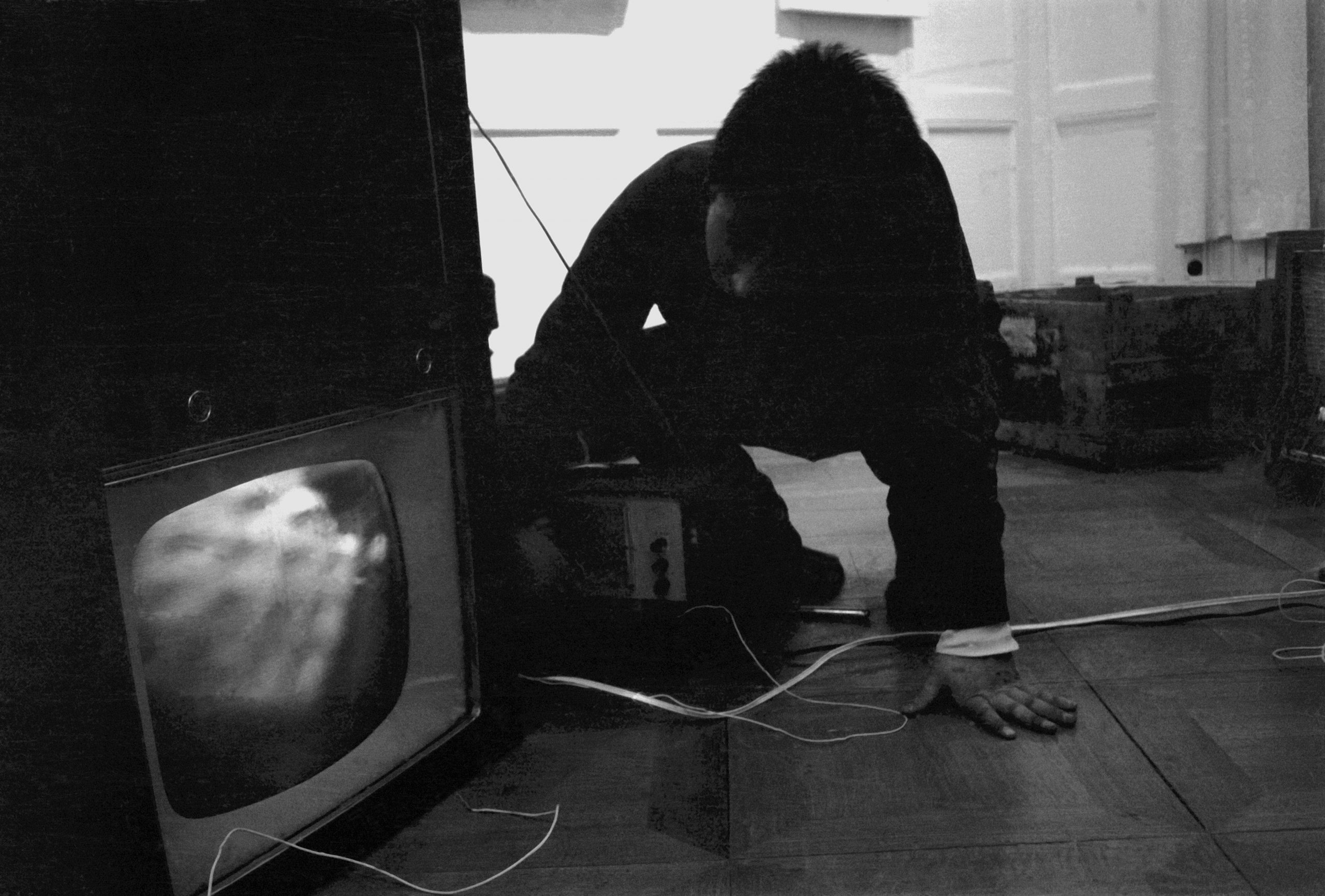
Manfred Montwé,Experimntal Television, Exposition of Music — Electronic Television, Galerie Parnass, Wuppertal

This photograph shows experimental televisions displayed in Nam June Paik’s first solo show, Exposition of Music — Electronic Television held at Galerie Parnass, Wuppertal, in March 1963. Paik showed 13 experimental televisions, which can be divided into three categories. The first group of televisions had their inner circuit manipulated to interfere with normal workings of signals; a broadcast program could be shown as negative images, or sinusoidal oscillations, horizontal, and vertical stripes could disturb the screen. The second group of televisions was connected to external devices by which the audience was led to participate, which made certain images. Stepping on a pedal switch or making sound in front of a microphone created dots of light like sparks on the television screen. Also, a television connected to a tape recorder and a radio displayed different images according to the wavelength of the music and the volume of the radio. The last group consisted of broken televisions that displayed a single horizontal line across the screen, which Paik brought and laid on its side so that the line appeared to be a vertical one. Another broken television was laid face-down, emphasizing its brand name ‘Rembrandt Automatic.’ Montwé recalled that images on the television monitors ran by rapidly, kept changing constantly, or remained unstable, making it technically challenging to capture them. The photograph shows Nam June Paik manipulating images on one of experimental televisions.
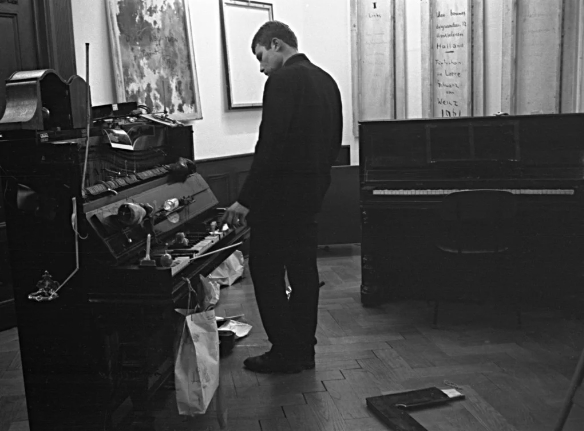
Manfred Montwé, Klavier Intégral, Exposition of Music — Electronic Television, Galerie Parnass, Wuppertal

This photograph shows Nam June Paik’s first solo show, Exposition of Music — Electronic Television held at Galerie Parnass, Wuppertal, in March 1963. At the central hall of the gallery, four pianos—the symbol of classical music—were displayed under the title of Klavier Intégral, prepared to be ‘played’ in a completely different way. One of the pianos was laid down to make viewers play it with their feet by stepping on the keys, and part of the piano was planed and ham¬mered. Another prepared piano was called “Piano for Arthur Køpcke,” modeled on Shut Books in which Køpcke glued a book’s pages so that it could not be read. Paik slotted a wooden panel inside the piano and closed the lid so that the keys could not be pressed and strings did not vibrate. The front cases of the other two pianos were removed, and their keys and strings were covered with everyday objects such as a doll’s head, a whistle, a horn, a plume, a spoon, a pile of coins, toy sundries, wires, photographs, a padlock, a brassiere, an accordion, an aphrodisiac, a disjointed arm, the lever of a record player, and among others.
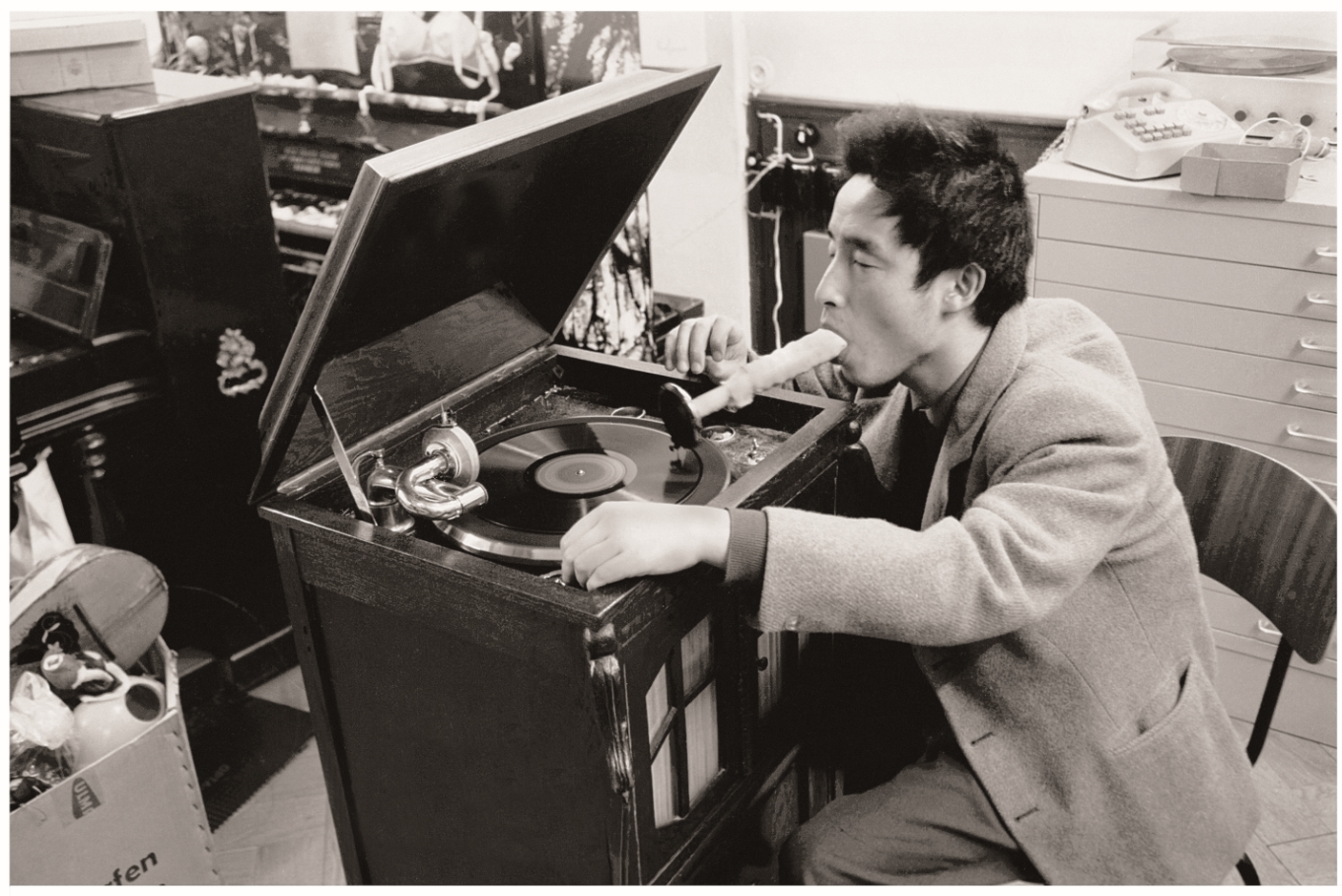
Manfred Montwé, Listening to Music through the Mouth, Exposition of Music — Electronic Television, Galerie Parnass, Wuppertal

Taken by Manfred Montwé, Listening to Music through the Mouth was one of the works featured in Nam June Paik’s first solo show, Exposition of Music — Electronic Television held at Galerie Parnass, Wuppertal, in March 1963. A cartridge was removed from an antique record player, and a phallic object was mounted instead. Placing a needle on the record, one would hold the phallic device in the mouth and listen to the record by feeling its vibrations. Paik transformed the organ that makes sound into one that hears the sound, tagged with an erotic connotation. According to Montwé’s recollections, Paik asked him to take a special picture, and in the morning when there was no visitor, Paik tried Listening to Music through the Mouth himself, to be photographed.
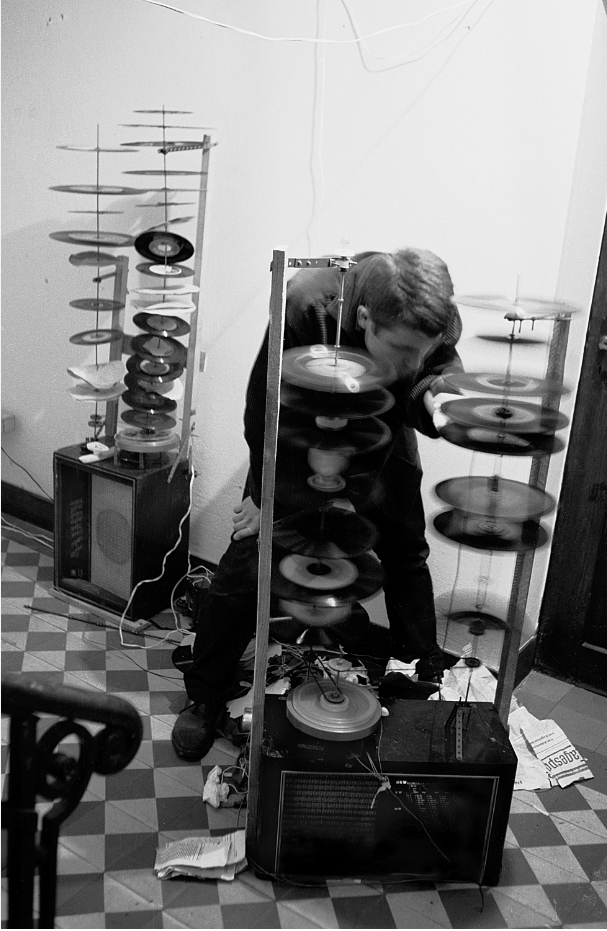
Nam June Paik, Record Schallplatten Schaschlik, Exposition of Music — Electronic Television, Galerie Parnass, Wuppertal

Manfred Montwé took a picture of Record Schallplatten Schaschlik, one of the works featured in Nam June Paik’s first solo show, Exposition of Music — Electronic Television held at Galerie Parnass, Wuppertal, in March 1963. In the gallery’s basement, a record player with a turntable was installed above a radio with a built-in amplifier and speaker. Ten vinyl records were randomly skewered to the elongated axis of the spinning turntable. Another similar pile of ten records was connected to the turntable with a rubber belt, rotating at the same speed—visitors holding a magnetic cartridge randomly scratch wherever they wanted. As the record pile looked like a skewered kebab, this work was entitled Record Schallplatten Schaschlik, borrowing the word ‘shashlik.’ This photograph shows Peter Brötzmann demonstrating this work.
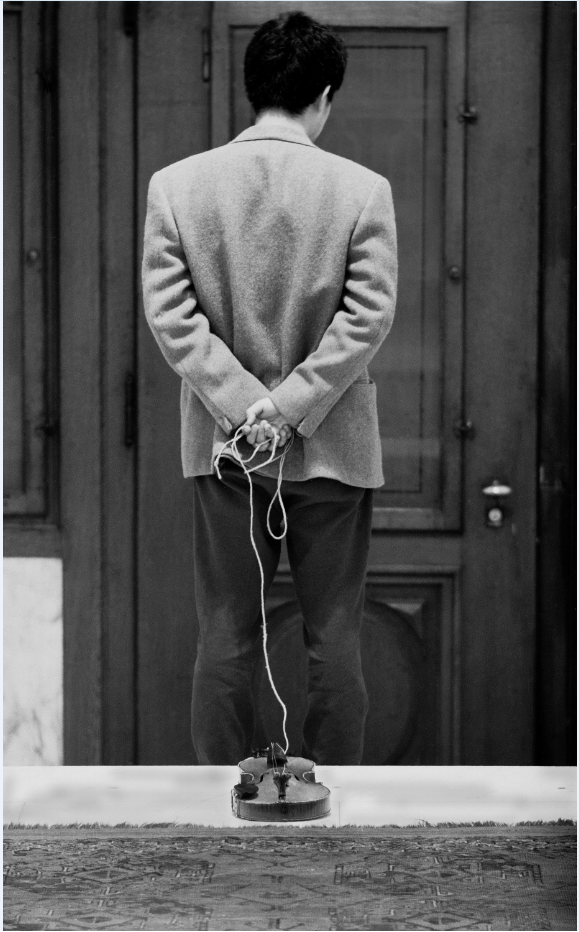
Nam June Paik,Zen for Walking, Exposition of Music — Electronic Television, Galerie Parnass, Wuppertal

Zen for Walking is a performance of slowly dragging various objects such as spoons or violins while walking down the street; the performance is occasionally titled alternately according to the dragged item. An objet d’art of the same name exists, which was used in one of the performances —pair of old sandals with a bell and carved Egyptian stone head entwined with chains that rattle with each step. Paik has never clarified the meaning of the objects attached to the sandals, yet the weighty stone head is suggestive of the arduousness of the creative process. Most important is the sound these objects make when dragged on the floor, which can be read as an homage to John Cage’s art that extended the idea of music to include noise and silence.
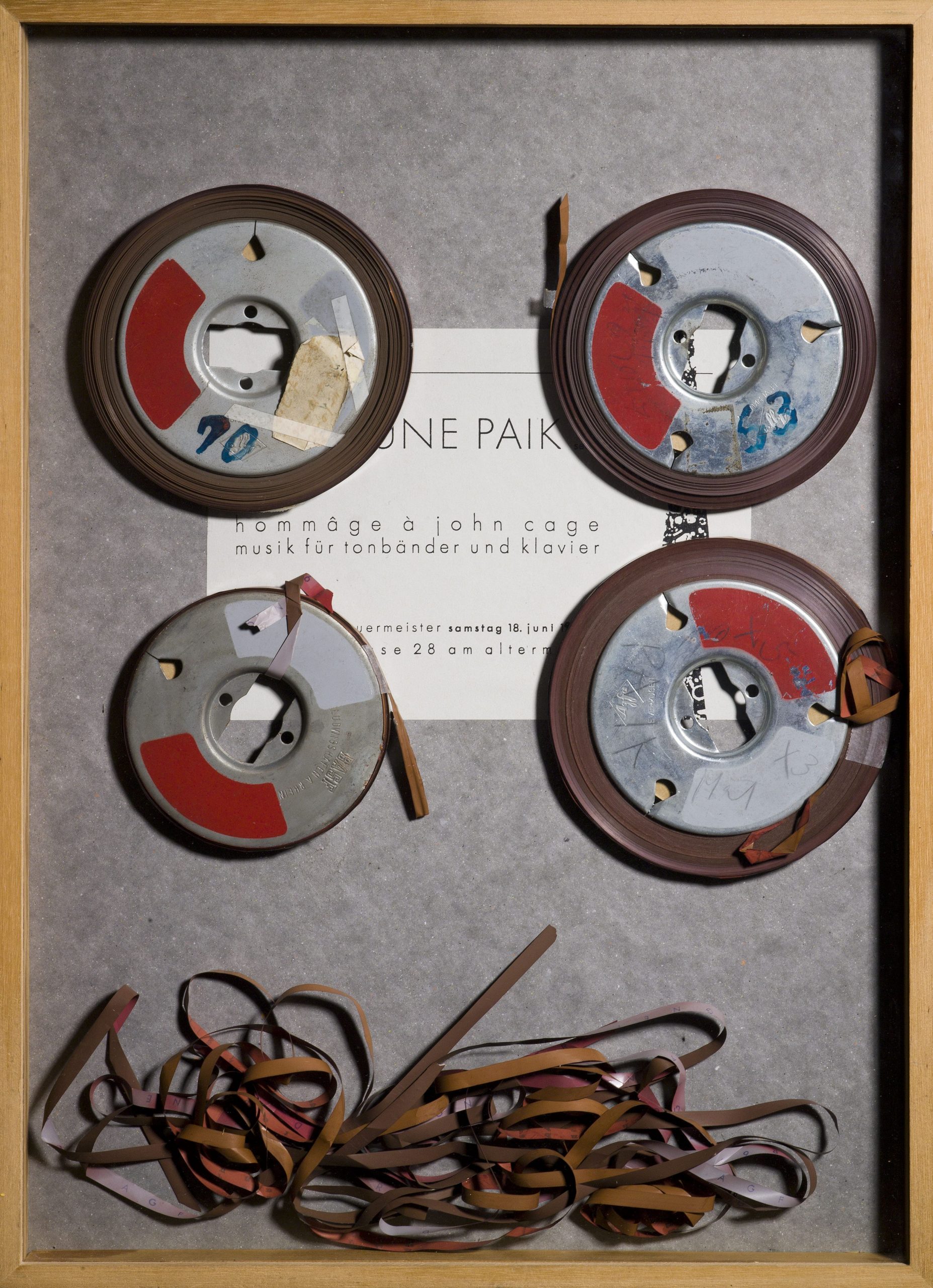
Nam June Paik,Hommage à John Cage: Music for Tapes and Piano

Deeply inspired by his acquaintance with John Cage, Nam June Paik performed Hommage à John Cage: Music for Tapes and Piano at the Galerie 22, Dusseldorf, in 1959. Upon his performance, Paik also produced a frame of the reel tapes that recorded collages of various sounds under the same title as the performance. The reel tapes contained an edited recording of classical music as well as daily noise; Beethoven’s Symphony No. 5, German Lieder, Rachmaninoff’s Piano Concerto No. 2, screaming sounds, glass shattering to pieces, pebbles rumbling in a tin box, crowing roosters, news and lottery announcements, and sounds of a prepared piano.
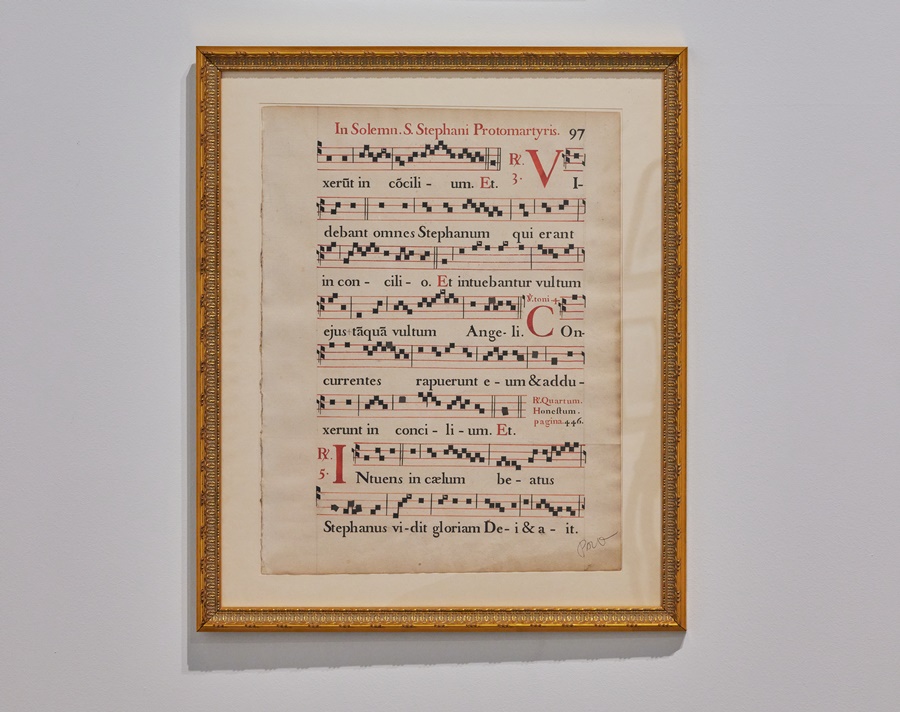
Nam June Paik, Random Access ― Medieval Musical Notation

This is one of the Gregorian chants, titled In Solemnity of St. Stephen the Protomartyr, written in the medieval musical notation: square neumes on a staff with four lines. In this notation, a square symbol marks a note in a melody, and sometimes a group of squares are sung to a single syllable. This system of neumes only represents an overall movement of the melody, and does not designate a specific pitch in absolute terms, so it depends on a singer which note to begin with, and which tune to follow. In this respect, it seems that the shape and structure of the medieval musical score, implying the possibility of ‘random’ performance, may have struck Paik with regard to his idea of ‘random access music’ that he materialized in 1963. Among his
Random Access series is the work in which fragments of unwound magnetic tapes were attached to the wall, and you could scrape the point you wanted to listen to, with a metal playback tape-head in your hand.
Giving the title again to a 15th-century music manuscript in which he attached ten square pieces of magnetic tape over original notes in places, Paik showed his consistent interest in the notion, “Random Access.”
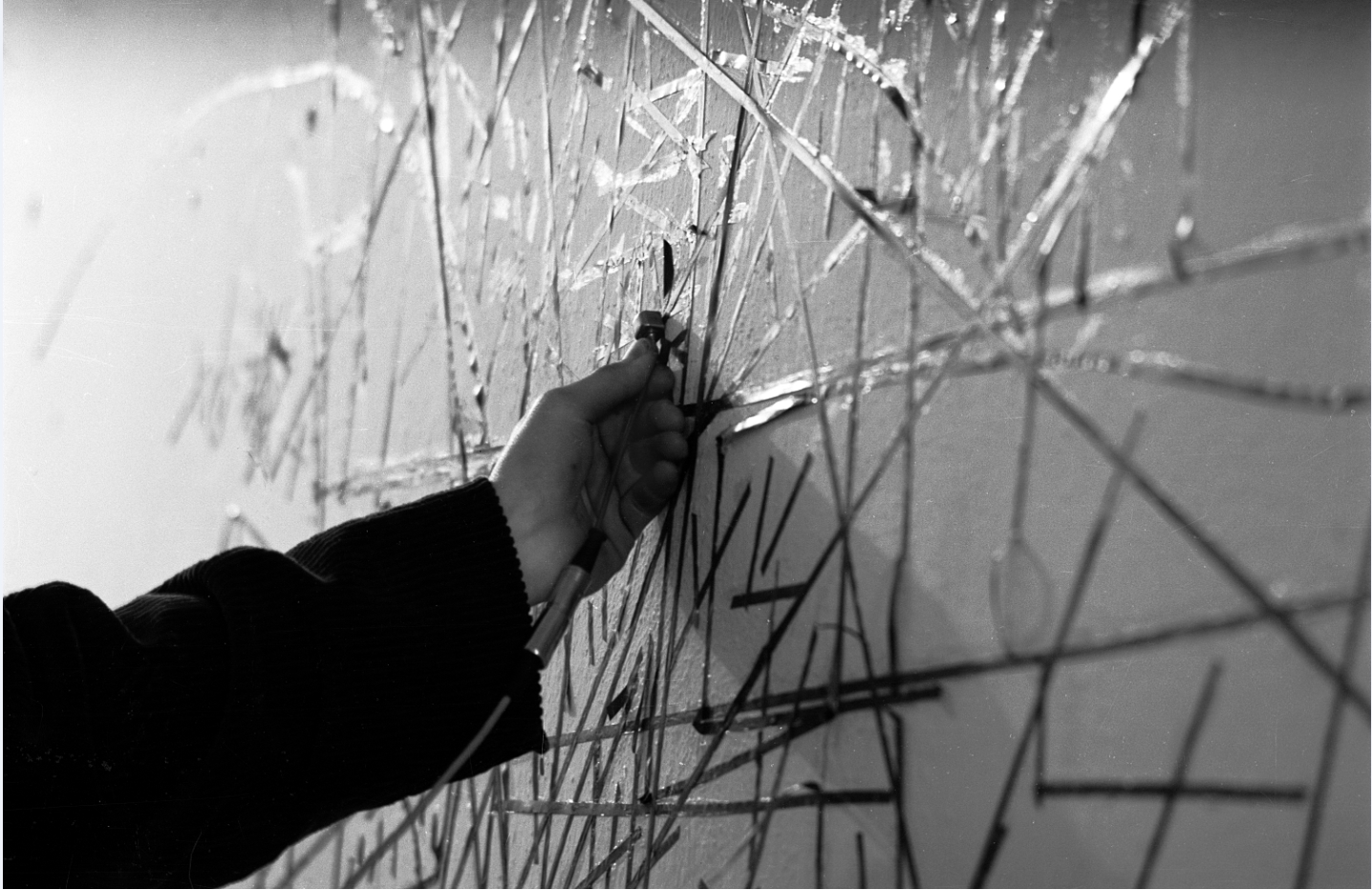
Manfred Montwé, Random Access, Exposition of Music — Electronic Television, Galerie Parnass, Wuppertal

Manfred Montwé took a picture of Random Access, one of the works featured in Nam June Paik’s first solo show, Exposition of Music — Electronic Television held at Galerie Parnass, Wuppertal, in March 1963. In the gallery’s basement, a motor-driven cardboard roller ran on two knee-height props. Fragments of magnetic tapes unwound from a spool were attached to a 50cm-wide segment of fabric moving on the roller like a conveyor belt. Tape fragments were also attached to the wall between two sets of fabric conveyor belts, like a city map. Visitors with a metal tape-head separated from playback equipment could scrape the point they wanted to listen to. One could hear various sounds depending on the speed and direction of scraping, which resembled distorted electronic music. Instead of listening to the sound sequentially played by a machine, visitors moved their bodies to listen to sound at a randomly selected spot; therefore, the work was called Random Access.
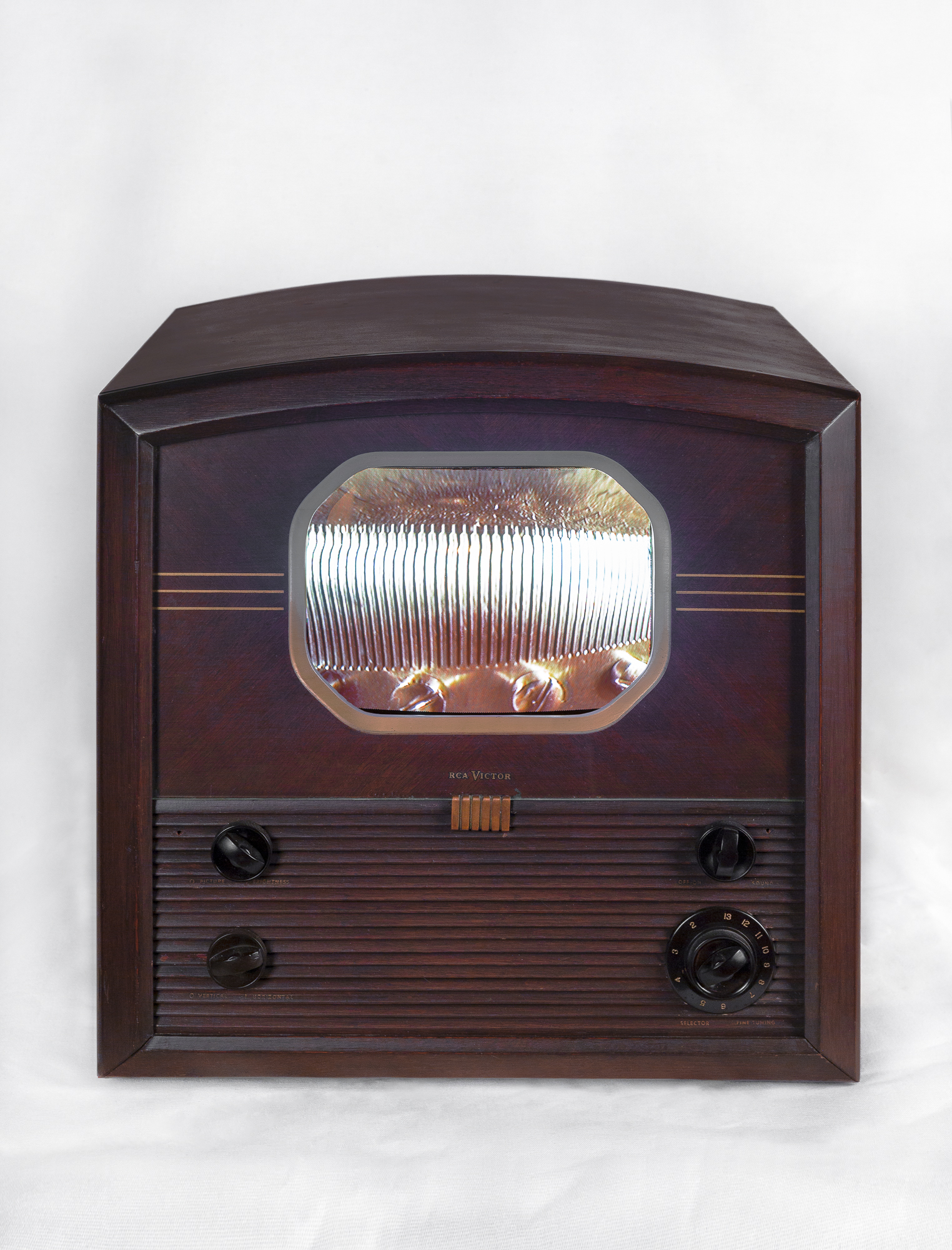
Nam June Paik, I Wrote it in Tokyo in 1954

I Wrote it in Tokyo in 1954 is based on Paik’s composition produced during his freshman year in college. The piece consists of 144 notes that comprise a single movement. Paik incorporated the movement into his 1994 work, and the piece was played by an antique musical instrument made in the 18th century. The composition was then displayed on an old TV set from the 1950s. The hypnotic image on the screen showed a revolving music box. The image, however, is not an actual mechanical device but an image captured and projected in real-time by a camera installed inside the TV set. Paik combined the image of modern electronics and the tradition of old but familiar TVs and music boxes to create a mixture of surrealism, poetry, and a little exaggeration. The past, the present, and even the future that Paik intended to show through his work all appear on the same screen.
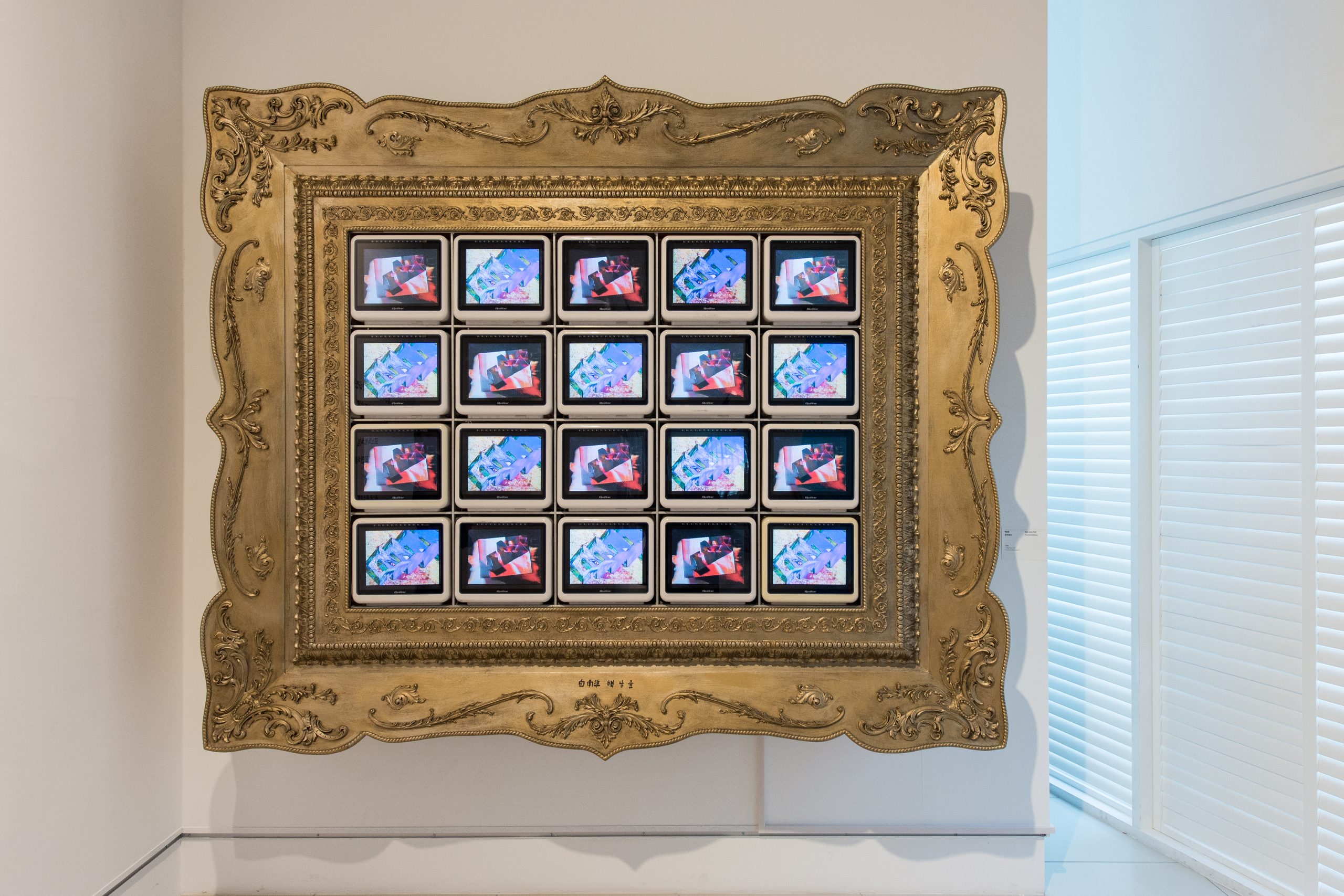
Nam June Paik, Fontainebleau

In a magnificent antique wooden frame painted in gold, twenty color (2-channel) monitors show rapidly-changing colorful abstract images. The title “Fontainebleau” appears to be taken from the Palace of Fontainebleau in France; the palace is not only the magnificent residence of French monarchs including Napoleon but also a place where the prototype of the ‘gallery’ that hung paintings side by side is located. The Gallery of Francis I, in particular, displayed paintings on the walls surrounded by splendid gold decorations. This work represents Paik’s idea of the following: “As the collage technique replaced oil painting, cathode-ray tubes will replace the canvas.”
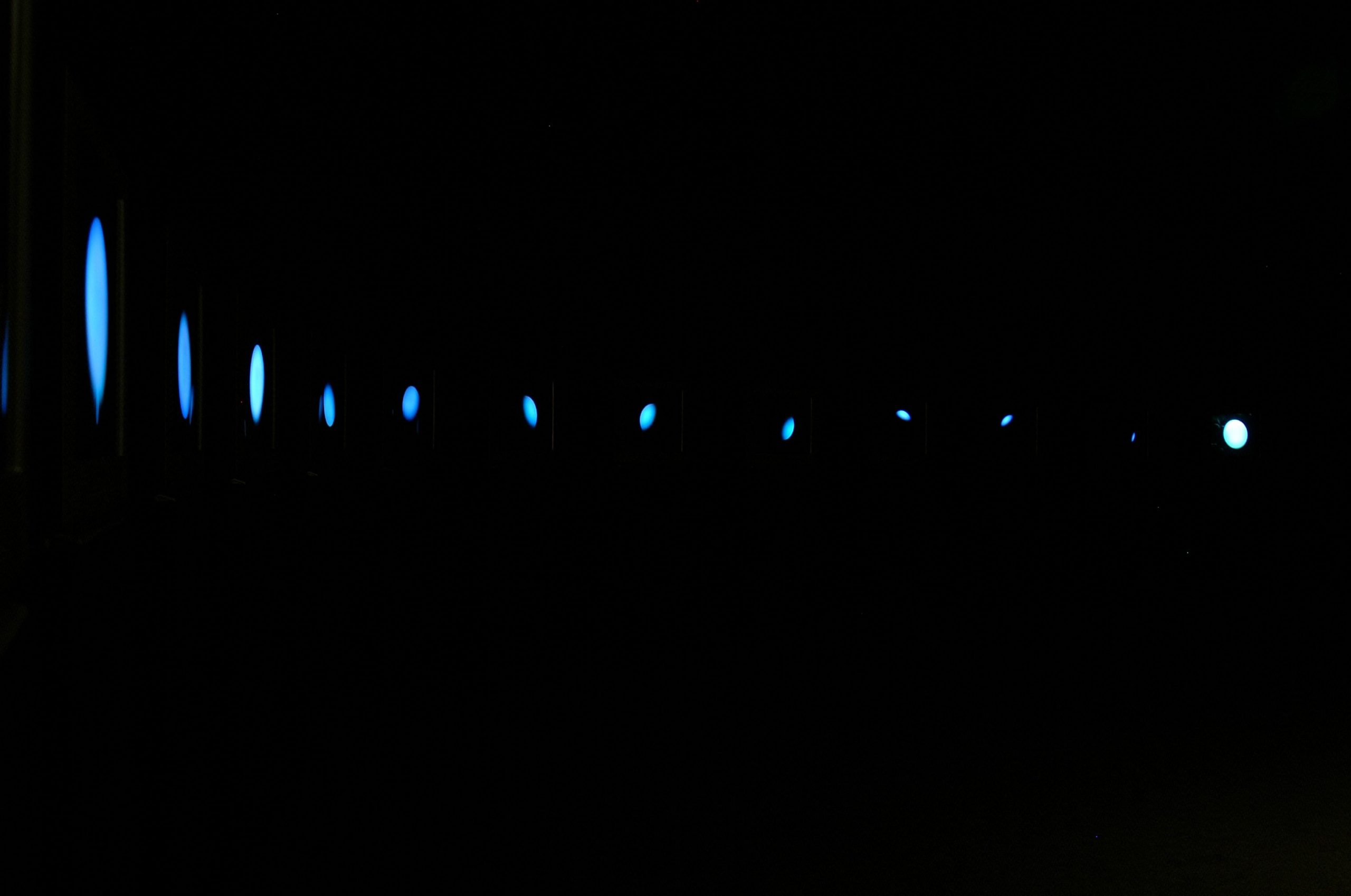
Nam June Paik,Moon is the Oldest TV

Nam June Paik enjoyed playing with time parameters in a spatial coordinate through video. In this work, Paik shows the moon, one of the oldest sources of light in the history of humanity, through the television monitor. Twelve different stages of the moon from the crescent to the full moon are embodied in twelve televisions. When this work was first on display at Galeria Bonino, New York, in 1965, an early model of the vacuum-tube television was used. Paik produced different images that looked like the cycle of the moon, simply by fixing a magnet in the tubes and thereby interfering with electromagnetic signals of the internal circuitry. After vacuum-tube televisions were discontinued, he videotaped moon-shaped images and displayed them on the monitors. Looking at the twelve phases of time, the viewer is invited to reflect on the depth and length of time, as well as the ephemerality and eternity of time simultaneously. The title seems to allude to the fact that in times when there were no televisions, people projected images and imagined stories while looking at the moon, the only natural satellite of Earth, which may be analogous to watching TV.
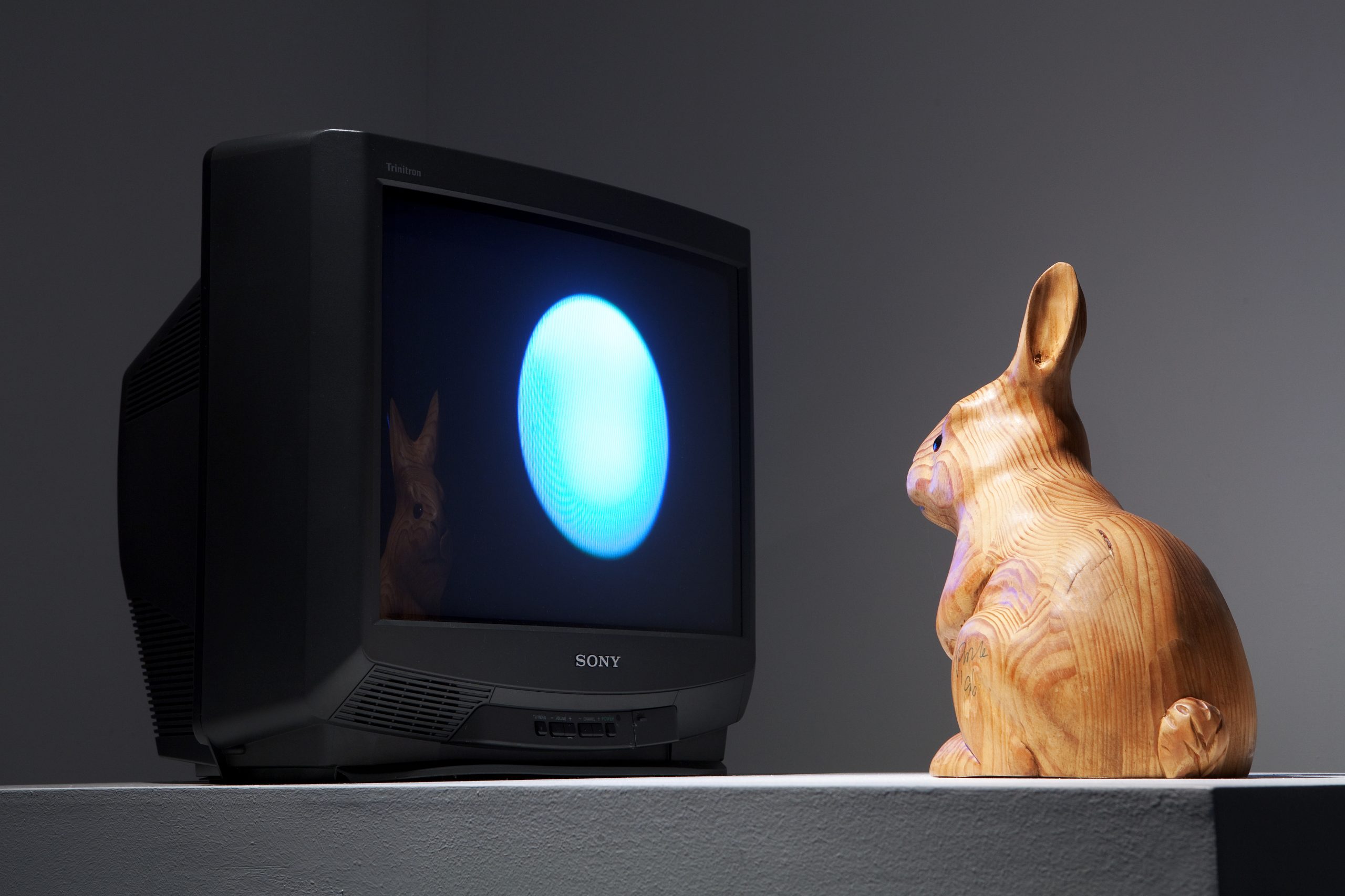
Nam June Paik, Rabbit Inhabits the Moon

Among Paik’s works that regard television and the moon together as information media is Rabbit Inhabits the Moon. It consists of a TV set and a wooden statue of rabbit watching the television. Often called a “jade rabbit,” the rabbit in the moon pounding with a mortar under a laurel tree, is a mythical figure in the Buddhist tale and in the Far Eastern folklore. The Korean children’ song, Bandal, meaning a half moon, also contains lyrics “On the Milky Way in the blue sky / Glides a little white boat / With a laurel tree and a rabbit.” In Paik’s work, the rabbit is looking at the TV monitor showing the moon where it is supposed to live. The moon shape on the screen is made by computer graphics. Mankind was able to watch the real moon when the historic moon landing was broadcast live on July 20, 1969, which was an epoch-making event of television history. Paik substituted a TV viewer for a rabbit to highlight the role of television bringing realities and imaginations together.
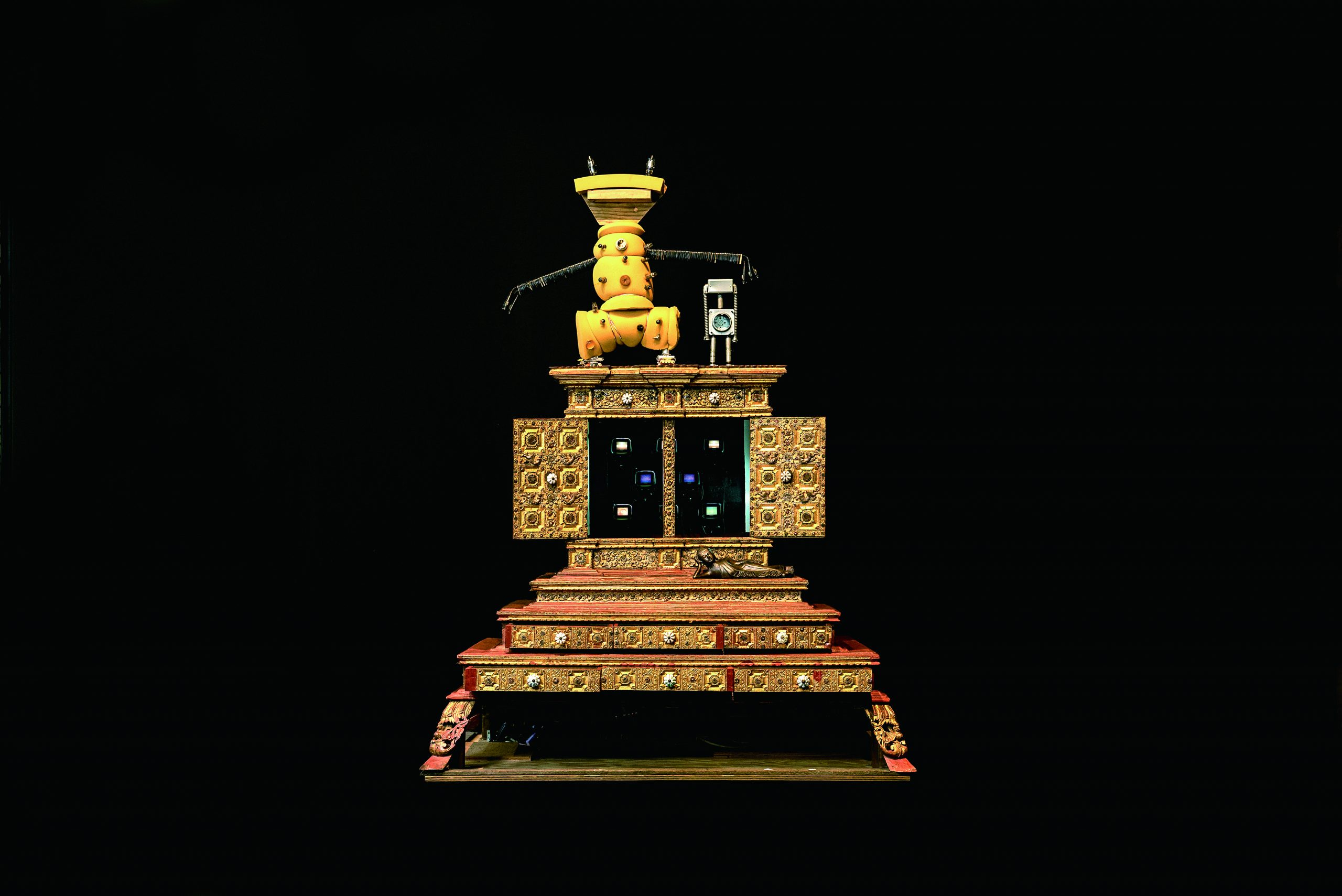
Nam June Paik, Burma Chest

The main element of Burma Chest is an ornamental Myanmar-style chest. Its lower part is a three-tier cabinet with drawers and the upper part is a cabinet with double doors as high as the lower one. The legs of the chest are carved, and the cabinets have elaborate flower patterns engraved. The drawer knobs have circular ceramic balls attached on, which look like white petals. Both sides of the swing doors have splendid decorations and carvings similar to the pattern on the lower cabinet. The bottom two tiers of the lower cabinet have three drawers each, which contain assorted metal ornaments, drawings, photographs and books. A reclining Buddha statue with his right hand supporting the head is placed on the pedestal that links the upper and lower parts of Burma Chest. Two robots are on the very top: a small robot is made of machinery components, and another robot whose framework is made of plywood and body and legs are wrapped with yellow sponge.
On the back wall inside the upper double-door cabinet are eight small LCD monitors. Four mini-beam projectors play 2-channel video on both sides, and another projector from the ceiling. The video includes clips of Paik’s Wrap Around the World(1988), Merce by Merce by Paik(1978), A Tribute to John Cage(1973), and Good Morning Mr. Orwell(1984), featuring Merce Cunningham, John Cage, Charlotte Moorman, Laurie Anderson, Joseph Beuys, and also images of alien beings and of the Carnival in Rio de Janeiro; it also shows Paik wearing dopo and gat, Korean traditional full-dress attire and hat extracted from Jean-Paul Fargier’s Play It Again, Nam(1990). As the furniture in the form of chest is generally used to store precious articles, Paik’s chest contains objects and videos full of old memories.
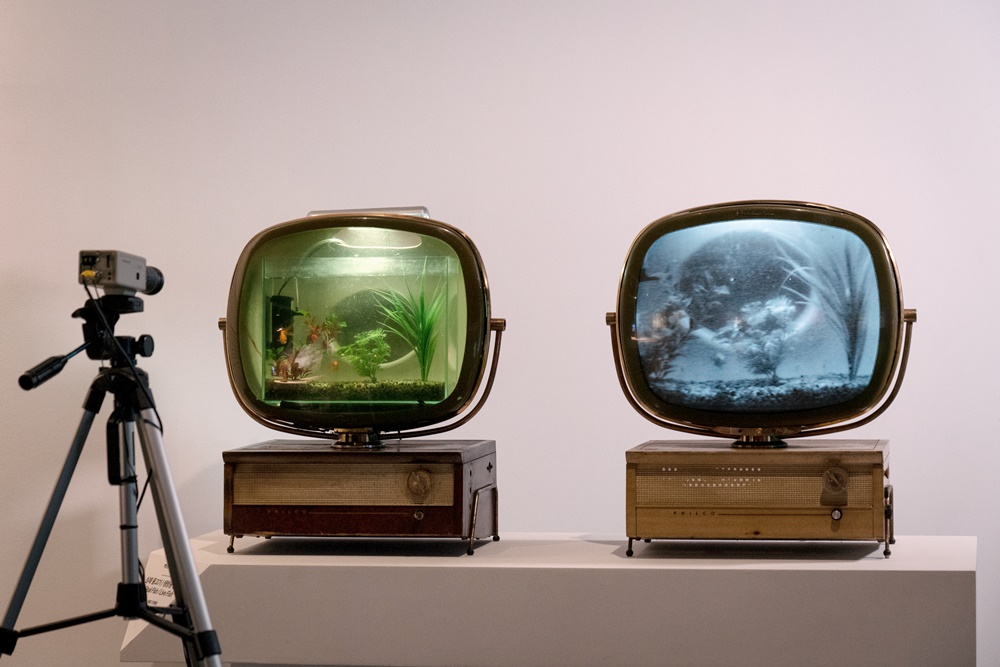
Nam June Paik Real Fish/Live Fish

There are two television sets, sitting side by side: a fish tank inside a television case on the left and a closed-circuit TV camera capturing and showing the fish in it live on the right television. This work employs Predicta, a cathode-ray tube television manufactured by Philco in the late 1950s Its highly refracted, swivel screen on top of a wooden console made it known as a futuristic TV design. Due to these formal characteristics of television that bears likeness to a fish tank, the composition turns all the more interesting. The corresponding words of “real” and “live” in the title hint at Paik’s pun. “Live” means “live broadcast” and also “alive,” so the title can be read as a repetition of the same meaning: “Real Fish / Living Fish.” It aims to ask whether recorded, represented images could be “alive” indeed.
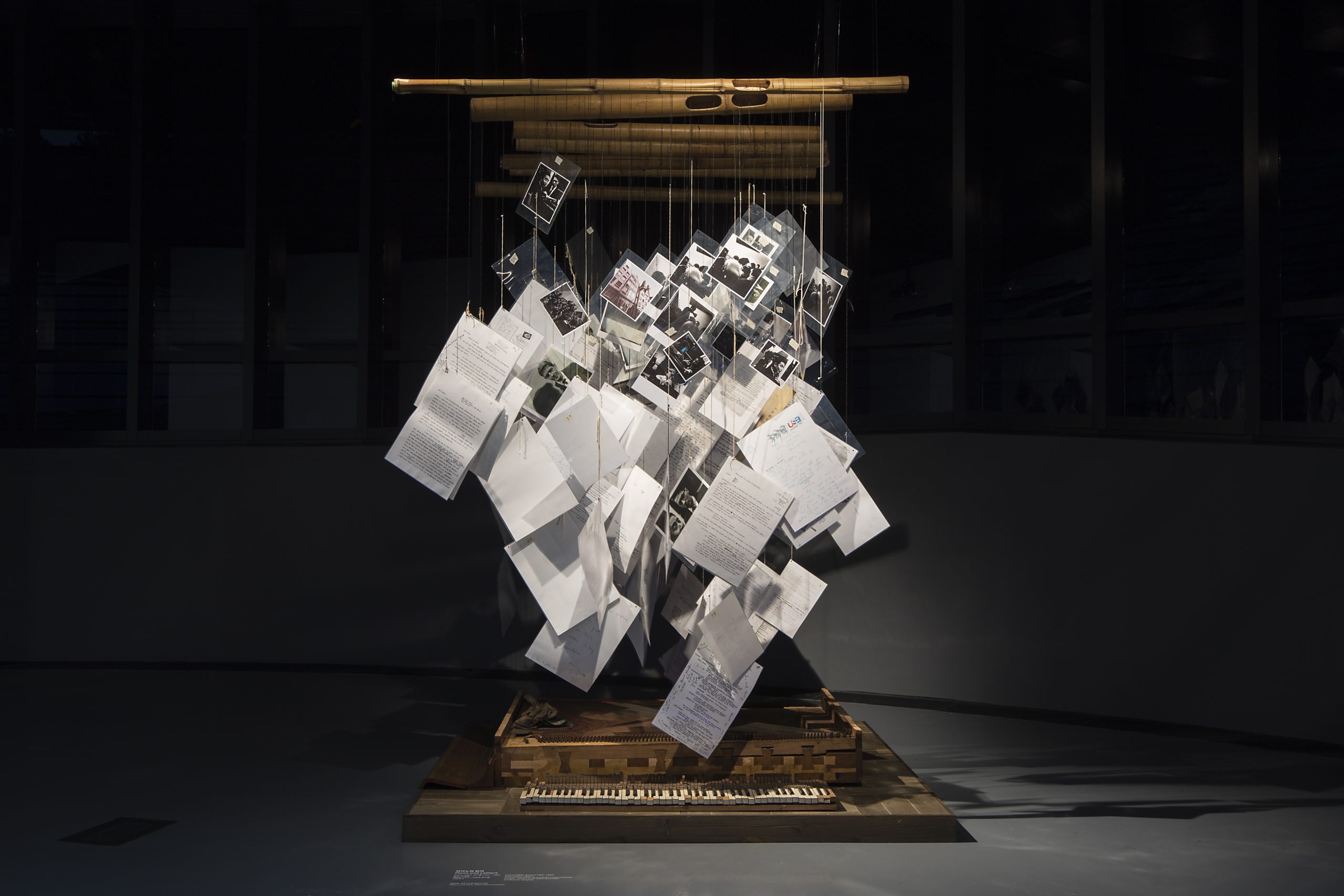
Nam June Paik, Mary Bauermeister, Piano & Letters

Mary Bauermeister was Nam June Paik’s close colleague and a Fluxus artist. Piano & Letters consists of written correspondences between the two artists, and scenes from a concert that took place in the early 1960s at Bauermeister’s studio. The piano, decked with paper and photographs, is also part of the actual object that was used at the concert. Along with Paik’s piece Klavier Intégral, which was introduced at Exposition of Music — Electronic Television, the destroyed piano shows the experimental spirit of the artists at the time, who expressed new concepts of art such as viewer participation, improvisation, and coincidence.
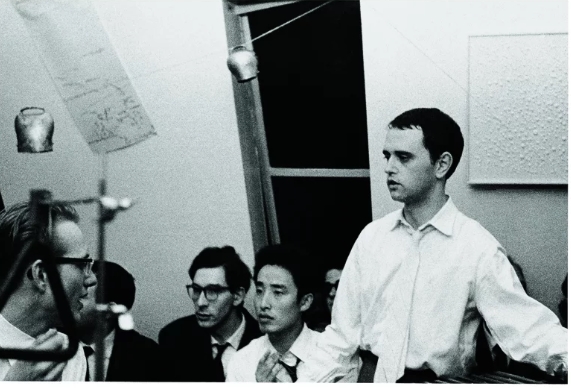
Manfred Leve, Cœur (Heart for Percussion), Contre-Festival zum Kölner IGNM-Fest, Mary Bauermeister's atelier, Cologne

Artists such as Karlheinz Stockhausen, Sylvano Bussotti, Hans G. Helms, Benjamin Patterson, I-Sang Yun, Christoph Caskel, David Tudor, and Nam June Paik participated in Contre-Festival zum Kölner IGNM-Fest held at Mary Bauermeister’s Cologne atelier in 1960. The photograph shows Bussotti in a white shirt performing Coeur (Heart for Percussion) (1959). Sitting next to him is Paik, who in Contre-Festival re-staged Hommage à John Cage that was premiered in Galerie 22 the previous year.
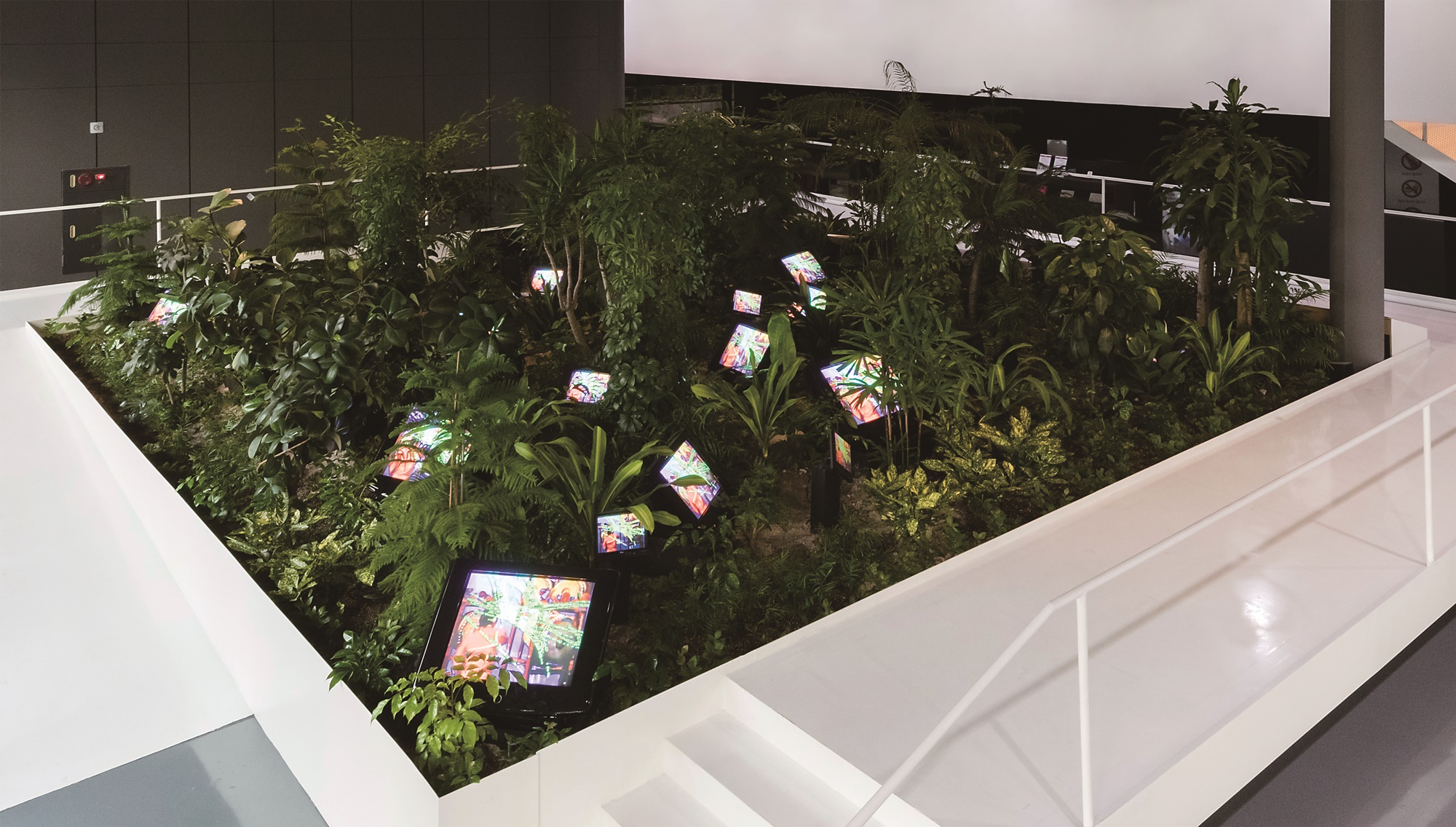
Nam June Paik,TV Garden

Television screens are blooming like large flowers in this dense garden of various plants and bushes. Placed in different directions and at unusual angles, rather than in the normal position to watch, television monitors reveal their presence by facing upwards or are tilting to one side. What is played on the monitors is Paik’s representative video Global Groove. The video proposes music and dance in diverse artistic and cultural forms as a method of global communication. In TV Garden, the natural environment created artificially inside the museum, on the one hand, and the television that serves as a representative of technology as opposite to nature, on the other hand, form a common space. Rather than capturing individual video images, viewers are left with the overriding holistic impression from the garden. TV Garden of Nam June Paik Art Center is the world only version planted in the flower bed and exhibited on a permanent basis.


